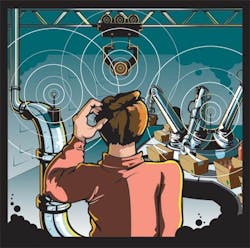Joaquin Ocampo suggests three things. “Auto-tuning, which has been around for a number of years, allows end-users to simplify the loop-tuning process,” says the product manager for motion control and drives at Bosch Rexroth Electric Drives and Controls (www.boschrexroth-us.com/brc), a Hoffman Estates, Ill., automation vendor. He also mentions multiple digital filters, which he says make systems more dynamically adjustable, as well as dynamic adjustment of loop settings. The latter allows optimal performance of a system when the load is constantly changing, he suggests.Add wireless PID closed-loop control to any list, suggests Greg McMillan, a principal consultant at Philadelphia-based CDI Process & Industrial (www.cdicorp.com), who works in the DeltaV research-and-development group with automation supplier Emerson Process Management (www.emersonprocess.com), Austin, Texas. However, limits exist on appropriate use. For example, wireless PID tuning can be used in loops with slow response times—minutes or hours—such as temperature loops in larger process vessels, he says.But such wireless control shouldn’t be used where loop response times are fast—sub-one second—or where the inability to control rapid process upsets or conditions could create damaging or dangerous situations or outcomes, McMillan cautions. “For liquid pressures and compressor surge control, you have to be careful, and probably not use wireless unless you did a lot of investigation. Why? Because very bad things could happen very quickly—essentially instantaneously.”To smarten wireless loop tuning and lessen unnecessary changes, Emerson released its V.11 to PID enhancements for wireless in May 2010. These enhancements are compatible with PIDPlus, an Emerson intelligent or smart loop-tuning technology. It considers delay from actions and what the operators then see, McMillan explains. Update or refresh time equals 16 seconds, he notes.Smart = sensitiveOne feature that intelligent wireless tuning offers, McMillan says, is exception reporting. “You set a ‘sensitivity’ [value] to trigger that.” For example, a sensor’s “wake-up” time lasts four seconds. If, during that interval, it measures that the sensitivity exceeds a preset trigger point, the sensor immediately will send a report noting that. Otherwise, the sensor goes back into sleep mode until its next wake-up, when the basic process repeats, he explains. One of the technology’s attractions is this power-saving potential, something that’s important for battery-powered wireless sensors in plant environments.However, a potential problem exists with such reporting. “What does the control loop do with the ‘old’ information? Can you use these wireless devices with 16-second refresh time on a process loop with response time of one to two seconds?” McMillan asks. The enhanced PID tuning accounts for elapsed time when making calculations, he answers. “In effect, you have a model of the process, in terms in how fast the process’ response time is. As a result, your loop will be stable right away.”Even with this intelligent tuning technology, though, “you’re not going to see what’s happening in the process until after the ‘wake-up’ time,” McMillan reminds, noting that the process disturbance could develop any time during that four-second interval. Nonetheless, the intelligent PID can make corrections “for going in the right direction with the right information,” he states. For example, “the enhanced PID may say, ‘I’m not going to do anything until I get an update. Then I’m going to make a calculation for the correction.’ ”What happens, though, if the measurement fails to update? With traditional PID loop tuning, “if you don’t get any updates, if the battery’s dead, or there’s some problem with the fieldbus—for whatever reason, measurement stops updating—the traditional PID tuner continues to ramp up or down to its limit,” McMillan comments.C. Kenna Amos, [email protected], is an Automation World Contributing Editor.Bosch Rexroth Electric Drives and Controlswww.boschrexroth-us.com/brcCDI Process & Industrialwww.cdicorp.comEmerson Process Managementwww.emersonprocess.com
Subscribe to Automation World's RSS Feeds for Columns & Departments
About the Author
C. Kenna Amos
Contributing Editor
Sign up for our eNewsletters
Get the latest news and updates

Leaders relevant to this article:
